Adjustable SM2 Lens Tubes
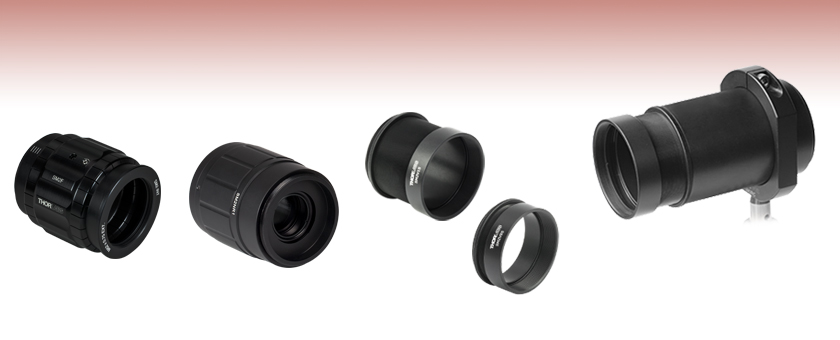
- Rotating Adjustment of Ø2" Optics
- Non-Rotating Adjustment of Ø1" Optics
- Internal and External SM2 (2.035"-40) Threads
SM2NR1
Non-Rotating Zoom Housing
SM2V15
SM2V10 Adjustable Lens Tube Connected to a Ø2" Lens Tube and Post-Mounted Using an SM2RC Slip Ring
SM2V05
Application Idea
Adjustable Lens Tubes
SM2F
Adjustable Collimation Adapter

Please Wait
Features
- Adjustable Positioning of Optics Along the Optical Axis within SM2 Lens Tube Systems
- Internally and Externally SM2 (2.035" -40) Threaded
- Rotating and Non-Rotating Optic Designs Available
Adjustable lens tubes allow for the adjustment of an optic's position along the optical axis within a lens tube system. Our adjustable lens tubes with extended external threads are designed to house a Ø2" optic and offer up to 1.31" (33.3 mm) of rotating optic travel. The SM2NR1 Zoom Housing provides 1.16" (29.5 mm) of non-rotating adjustment at 17 mm per revolution for a Ø1" optic; it can be mounted between two fixed lens tubes. The SM2F Adjustable Collimation Adapter provides 20 mm of non-telescoping, rotating adjustment of a Ø2" (Ø50 mm) collimation optic.
| Alternatives | Ø1/2", Ø1", Ø1.5", and Ø3" Adjustable Lens Tubes | Ø1" Non-Rotating Adjustable Focus Lens Tubes | |
|---|---|---|---|
| SM05 Threading: Ø1/2" Lens Tubes, 16 mm Cage Systems | |||
|---|---|---|---|
| External Thread, 0.535"-40.0 UNS-2A | Internal Thread, 0.535"-40.0 UNS-2B | ||
| Max Major Diameter | 0.5340" | Min Major Diameter | 0.5350" |
| Min Major Diameter | 0.5289" | Min Pitch Diameter | 0.5188" |
| Max Pitch Diameter | 0.5178" | Max Pitch Diameter | 0.5230" |
| Min Pitch Diameter | 0.5146" | Min Minor Diameter (and 83.3% of Thread) | 0.508" |
| Max Minor Diameter | 0.5069" | Max Minor Diameter (and 64.9% of Thread) | 0.514" |
| RMS Threading: Objective, Scan, and Tube Lenses | |||
|---|---|---|---|
| External Thread, 0.800"-36.0 UNS-2A | Internal Thread, 0.800"-36.0 UNS-2B | ||
| Max Major Diameter | 0.7989" | Min Major Diameter | 0.8000" |
| Min Major Diameter | 0.7934" | Min Pitch Diameter | 0.7820" |
| Max Pitch Diameter | 0.7809" | Max Pitch Diameter | 0.7866" |
| Min Pitch Diameter | 0.7774" | Min Minor Diameter (and 83.3% of Thread) | 0.770" |
| Max Minor Diameter | 0.7688" | Max Minor Diameter (and 64.9% of Thread) | 0.777" |
| C-Mount Threading: Machine Vision Lenses, CCD/CMOS Cameras | |||
|---|---|---|---|
| External Thread, 1.000"-32.0 UN-2A | Internal Thread, 1.000"-32.0 UN-2B | ||
| Max Major Diameter | 0.9989" | Min Major Diameter | 1.0000" |
| Min Major Diameter | 0.9929" | Min Pitch Diameter | 0.9797" |
| Max Pitch Diameter | 0.9786" | Max Pitch Diameter | 0.9846" |
| Min Pitch Diameter | 0.9748" | Min Minor Diameter (and 83.3% of Thread) | 0.966" |
| Max Minor Diameter | 0.9651" | Max Minor Diameter (and 64.9% of Thread) | 0.974" |
| SM1 Threading: Ø1" Lens Tubes, 30 mm Cage Systems | |||
|---|---|---|---|
| External Thread, 1.035"-40.0 UNS-2A | Internal Thread, 1.035"-40.0 UNS-2B | ||
| Max Major Diameter | 1.0339" | Min Major Diameter | 1.0350" |
| Min Major Diameter | 1.0288" | Min Pitch Diameter | 1.0188" |
| Max Pitch Diameter | 1.0177" | Max Pitch Diameter | 1.0234" |
| Min Pitch Diameter | 1.0142" | Min Minor Diameter (and 83.3% of Thread) | 1.008" |
| Max Minor Diameter | 1.0068" | Max Minor Diameter (and 64.9% of Thread) | 1.014" |
| SM30 Threading: Ø30 mm Lens Tubes | |||
|---|---|---|---|
| External Thread, M30.5 x 0.5 – 6H/6g | Internal Thread, M30.5 x 0.5 – 6H/6g | ||
| Max Major Diameter | 30.480 mm | Min Major Diameter | 30.500 mm |
| Min Major Diameter | 30.371 mm | Min Pitch Diameter | 30.175 mm |
| Max Pitch Diameter | 30.155 mm | Max Pitch Diameter | 30.302 mm |
| Min Pitch Diameter | 30.059 mm | Min Minor Diameter (and 83.3% of Thread) | 29.959 mm |
| Max Minor Diameter | 29.938 mm | Max Minor Diameter (and 64.9% of Thread) | 30.094 mm |
| SM1.5 Threading: Ø1.5" Lens Tubes | |||
|---|---|---|---|
| External Thread, 1.535"-40 UNS-2A | Internal Thread, 1.535"-40 UNS-2B | ||
| Max Major Diameter | 1.5339" | Min Major Diameter | 1.535" |
| Min Major Diameter | 1.5288" | Min Pitch Diameter | 1.5188" |
| Max Pitch Diameter | 1.5177" | Max Pitch Diameter | 1.5236" |
| Min Pitch Diameter | 1.5140" | Min Minor Diameter (and 83.3% of Thread) | 1.508" |
| Max Minor Diameter | 1.5068" | Max Minor Diameter (and 64.9% of Thread) | 1.514" |
| SM2 Threading: Ø2" Lens Tubes, 60 mm Cage Systems | |||
|---|---|---|---|
| External Thread, 2.035"-40.0 UNS-2A | Internal Thread, 2.035"-40.0 UNS-2B | ||
| Max Major Diameter | 2.0338" | Min Major Diameter | 2.0350" |
| Min Major Diameter | 2.0287" | Min Pitch Diameter | 2.0188" |
| Max Pitch Diameter | 2.0176" | Max Pitch Diameter | 2.0239" |
| Min Pitch Diameter | 2.0137" | Min Minor Diameter (and 83.3% of Thread) | 2.008" |
| Max Minor Diameter | 2.0067" | Max Minor Diameter (and 64.9% of Thread) | 2.014" |
| SM3 Threading: Ø3" Lens Tubes | |||
|---|---|---|---|
| External Thread, 3.035"-40.0 UNS-2A | Internal Thread, 3.035"-40.0 UNS-2B | ||
| Max Major Diameter | 3.0337" | Min Major Diameter | 3.0350" |
| Min Major Diameter | 3.0286" | Min Pitch Diameter | 3.0188" |
| Max Pitch Diameter | 3.0175" | Max Pitch Diameter | 3.0242" |
| Min Pitch Diameter | 3.0133" | Min Minor Diameter (and 83.3% of Thread) | 3.008" |
| Max Minor Diameter | 3.0066" | Max Minor Diameter (and 64.9% of Thread) | 3.014" |
| SM4 Threading: Ø4" Lens Tubes | |||
|---|---|---|---|
| External Thread, 4.035"-40 UNS-2A | Internal Thread, 4.035"-40.0 UNS-2B | ||
| Max Major Diameter | 4.0337" | Min Major Diameter | 4.0350" |
| Min Major Diameter | 4.0286" | Min Pitch Diameter | 4.0188" |
| Max Pitch Diameter | 4.0175" | Max Pitch Diameter | 4.0245" |
| Min Pitch Diameter | 4.0131" | Min Minor Diameter (and 83.3% of Thread) | 4.008" |
| Max Minor Diameter | 4.0066" | Max Minor Diameter (and 64.9% of Thread) | 4.014" |
| Posted Comments: | |
Mikael Malmström
(posted 2020-06-11 10:56:31.613) How can I go from SM2F directly to SM3? I can not find an adapter from M62 to SM3...
I want to be able to move a SM2 negative lens outside of the SM2F into a SM3 tube. YLohia
(posted 2020-06-11 12:01:33.0) Thank you for contacting Thorlabs. You may use the SM3A2 adapter to connect the SM2F to an SM3 tube. It features external SM2 threads and internal SM3 threads. |

Adjustable Lens Tube Usage
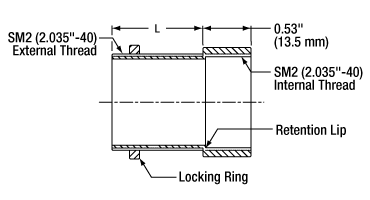
Simplified Mechanical Drawing
- Three Adjustment Ranges
- SM2V05: 0.31" (7.9 mm)
- SM2V10: 0.81" (20.6 mm)
- SM2V15: 1.31" (33.3 mm)
- Long Externally Threaded Section for Adjustable Positioning of Mounted Optics
- Maximum Optic Thickness of 0.4" (10 mm) using Included SM2RR Retaining Ring
These SM2-threaded (2.035"-40) adjustable lens tubes have an extra-long externally threaded section, allowing Ø2" optics to be positioned along the optical axis of a Ø2" lens tube system. To operate, mount the optic in the internally threaded section using the included SM2RR retaining ring. Then thread the adjustable lens tube into a compatible (i.e., matching threads) lens tube or SM2-threaded lens mount until the optic is at the desired position. Use the included SM2NT locking ring to fix the position of the lens tube.
For applications where it is difficult to reach the locking ring by hand, we offer the SM2NT1 Slotted Locking Ring and SPW503 Spanner Wrench. This locking ring contains slots for the 2¼" end of the spanner wrench.
These adjustable lens tubes are an ideal solution for fine tuning of the first and last lenses in a lens tube system. Although a lens tube can be attached to the front of the adjustable lens tube, it should only be done after the position has been fixed, since this lens tube will need to be free to rotate and translate if the position is changed. Like our standard lens tubes, these adjustable lens tubes are made of black anodized aluminum.
| Item # | External Thread Length (L) | Maximum Adjustment Rangea |
|---|---|---|
| SM2V05 | 0.5" (12.7 mm) | 0.31" (7.9 mm) |
| SM2V10 | 1.0" (25.4 mm) | 0.81" (20.6 mm) |
| SM2V15 | 1.5" (38.1 mm) | 1.31" (33.3 mm) |

SM2NR1 Zoom Housing Usage
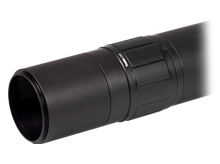
Click to Enlarge
The SM2NR1 zoom housing can be mounted between two fixed SM2 lens tubes.
- Adjustable Positioning of Ø1" Optics within SM2 Lens Tube Systems Without Rotation
- 1.16" (29.5 mm) of Non-Rotating Adjustment at 17 mm Per Revolution
- Mounts Ø1" Optics with Included SM1RR Retaining Ring
- Internal and External SM2 (2.035"-40) Threads
- Mounts Between Two Fixed SM2 Lens Tubes
Thorlabs' SM2NR1 provides 1.16" (29.5 mm) of non-rotating adjustment for Ø1" optics in a lens tube system. The SM2NR1 is SM2-threaded (2.035"-40) and can be mounted between two fixed lens tubes. It contains an internally SM1-threaded (1.035"-40) cell where optics are installed using the included SM1RR retaining ring. A double helical mechanism moves the optic back and forth while restricting any rotational movement.

- Translation of Ø2" or Ø50 mm Collimation Optic with 20 mm of Travel
- External SM1 Threading (1.035"-40) at Input and Internal SM2 Threading (2.035"-40) at Output
- Removable Threading Adapters at Input and Output; Remove the Input Adapter for SM2 Thread Compatibility at Both Ends
- 10.0 mm (0.39") Thick Retaining Ring Ideal for Aspheric Lenses
- Recommended for Collimating Mounted LEDs Using Condenser Lenses
This Adjustable Collimation Adapter provides 20 mm of non-telescoping, rotating translation for a Ø2" (Ø50 mm) optic with a clear aperture of Ø47.0 mm. As seen in the drawing to the right, the input and output apertures of the adapter are equipped with removable thread adapters. The input adapter is externally SM1 threaded (1.035"-40) and internally SM2 threaded (2.035"-40); removing it provides compatibility with SM2-threaded components. The output thread adapter is externally M62 x 0.75 threaded and internally SM2 threaded. We also offer versions with pre-mounted aspheric condensers here. The SM2F should be used at temperatures from 15 to 60 °C (non-condensing).
The inner carriage can be translated along the Z-axis by turning the adjustment ring (engraved with the Item # in the photos to the left) and locked into position by turning the locking screw on the side of the adjustment ring with a 2 mm (5/64") hex key. While the lens cell will rotate within the adapter housing when translated, the mounting threads on the housing remain fixed, allowing the SM2F to be mounted between fixed lens tubes. Lines with a 2 mm spacing are engraved on the housing as a rough guide for how far the carriage has been translated. Each collimation adapter also includes a 10-mm-thick, SM2-threaded retaining ring that allows an aspheric condenser lens to be mounted with our SPW604 Spanner Wrench.
Inserting or Removing Optics
To insert or remove an optic in these collimation adapters, use the adjustment ring to translate the inner carriage to the output end of the housing. Remove the included retaining ring using the SPW604 spanner wrench. If there is a lens installed already, remove it from the carriage. Insert another Ø2" or Ø50 mm optic into the carriage, and use the retaining ring to secure it.
 Products Home
Products Home









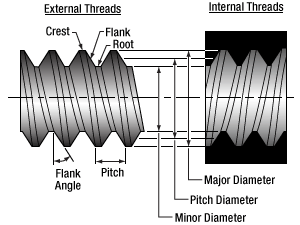
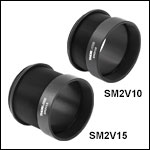
 Zoom
Zoom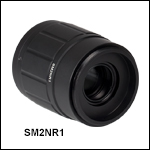
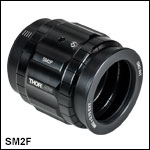
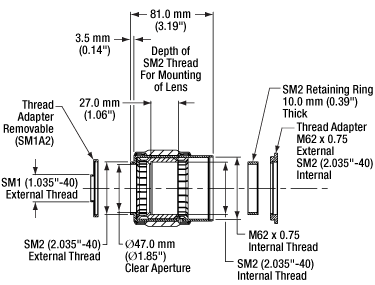
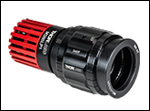
 Adjustable Ø2" Lens Tubes
Adjustable Ø2" Lens Tubes